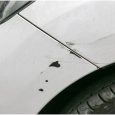A tire blowout can occur randomly for a multitude of different reasons. It could be that the tire pressure was too off and the rubber couldn’t sustain it or a nail was in the road that no one could see. Regardless, there are steps you need to take to ensure that not only you but other drivers are safe.

Here is your step-by-step guide to dealing with a tire blowout.
-
Pull Over Safely
If the tire has blown out while driving, remain calm and try not to swerve the vehicle. A tire blowout accident can lead to panic which could make the situation worse.
You’re going to need to safely pull over into the shoulder. Preferably the right-hand side as this will be the side with the most amount of space between you and the other cars.
-
Check for Damage and a Spare Tire
Once you’re safely away from other cars, you’ll want to check that everyone is okay and that your vehicle is okay.
The rubber leaving the car and sometimes leaves damage when falling backward, so you might need to get a flashlight and check under the car. Don’t get underneath the car, as the vehicle is not on all wheels and could fall on you.
Check to see if you have a spare on hand. The three places to check will be in the truck underneath the board, on the back of the car, or underneath the car.
If you don’t have a spare, check out this mobile tire service to come and replace your tires for you.
-
Remove Blown Out Tire and Replace With Spare
To replace the tire, you’ll need to have a jack and a way to remove the bolts. Your spare tire will either be a compact spare tire or a full-size spare tire.
Do note that compact spare tires should only be driven on temporarily and should never exceed 50 miles per hour.
-
Ensure Tire Pressure Is Correct Between All Tires
Once you’ve replaced the spare, check that the tire pressure is the same between all tires. If you have an air pump on you, fill the tire to the minimum pressure listed.
The tire should list somewhere on it what the minimum and maximum tire pressure ranges are.
-
Get Your Vehicle Serviced
When you’re back home, get the vehicle serviced and replace the tire.
Auto shops will be able to tell you if there was any underlying damage from the blowout. They can also check to see if there are any other problems with your tires and if you should get new ones or not.
Be Prepared for a Tire Blowout Ahead of Time
Don’t wait for a tire blowout to occur. If you see a check tire pressure light come on, check the wheel and see what is causing the problem. It is always better to replace a tire ahead of time rather than to wait and take the risk of driving it.
If you want to learn more about taking care of your car, then be sure to check out the rest of our blog. Be sure to share this article with friends and family so they know what to do in the event of a tire blowout.




